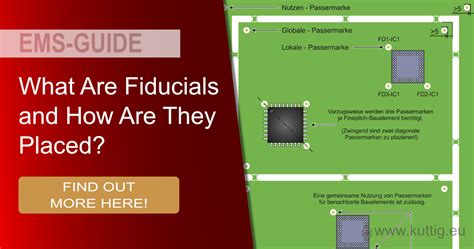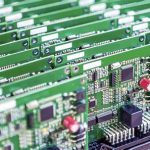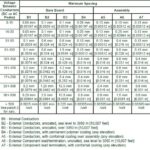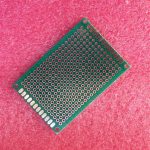What are PCB Fiducials?
Printed Circuit Board (PCB) fiducials are small circular copper pads or marks placed on blank areas of a PCB. They serve as reference points for automated assembly equipment to accurately place and orient surface mount components during the pick-and-place process.
Fiducials help ensure proper alignment between the PCB and the component placement head. By providing positional feedback, fiducials allow pick-and-place machines to compensate for any minor misalignments or offsets.
Fiducials are critical for high-precision, high-volume PCB Assembly. They become especially important with high-density boards containing many small components. Proper Fiducial Placement helps achieve consistent manufacturing quality.
How Many Fiducials Should Be Used?
The number of fiducials needed depends on the size and complexity of the PCB:
| PCB Size | Recommended Fiducials |
|---|---|
| < 50 mm ^ 2 | 1 global |
| 50-300 mm^2 | 2 global (1 local optional) |
| > 300 mm^2 | 3 global (locals optional) |
-
For small, simple PCBs under 2 sq. inches, a single global fiducial is usually sufficient.
-
Mid-sized PCBs between 2-12 sq. inches should have at least 2 global fiducials on diagonally opposite corners. A local fiducial can optionally be added near critical components.
-
Large, complex PCBs over 12 sq. inches need a minimum of 3 global fiducials in a triangular configuration. Additional local fiducials can be used for critical parts if needed.
Local fiducials provide secondary reference points for especially tight-tolerance parts. But global fiducials should always be the primary guide for overall board positioning.
Fiducial Size and Shape
The standard fiducial is a solid round copper pad. A circular shape allows the vision system to locate the center point regardless of rotational orientation.
Fiducial diameter should be:
- Large enough for easy optical recognition
- Small enough to fit in available space
- Round and symmetrical for easy centroid calculation
Typical fiducial sizes range from 0.75-3.0 mm in diameter, with 1.0-1.5 mm being most common. Smaller fiducials may be used on dense PCBs but require higher resolution cameras.
The copper pad stack-up for fiducials is:
| Layer | Thickness (µm) |
|---|---|
| Copper | 17.5 – 70 |
| Solder Mask | 10 – 20 |
| Finish | 0.5 – 30 |
A thicker copper layer makes fiducials more distinct. The top finish, usually HASL, immersion silver or gold, or OSP, protects the exposed copper.
A solder mask opening slightly larger than the copper pad clearly defines the fiducial against the green PCB Substrate. The mask opening should have a clean, round edge.
Where to Place Fiducials on a PCB
Global Fiducial Placement
The main rules for global fiducial placement are:
- Place in diagonally opposite corners for 2 fiducials
- Place in an equilateral triangle for 3 fiducials
- Locate in symmetrically in blank areas of the board
- Provide adequate clearance from components and edges
Diagonally opposite placement provides maximum separation between reference points. An equilateral triangular arrangement with 3 fiducials gives the best stability.
Fiducials must be in completely blank areas free of components, traces, vias, or silkscreen. Provide at least 1-2mm keep-out area around fiducials.
Typical clearances from board edges are:
| Edge | Clearance |
|---|---|
| Top/Bottom | 5 mm |
| Left/Right | 3 mm |
Avoid placing fiducials under tall parts like capacitors or connectors that could obscure overhead camera vision.
If possible, put fiducials on the same side of the PCB as components (usually top side). For double-sided SMT boards, place fiducials symmetrically on top and bottom sides.
Local Fiducial Placement
Position local fiducials within 6-8 mm of critical components like fine-pitch BGAs or CSPs. Align local fiducials with the centerline of the component land pattern.
Follow similar spacing guidelines as global fiducials:
- Minimum 1 mm from adjacent components and traces
- Preferably on the same side as its reference component
- Near the geometrical center of the grouping
- Do not place on a mating connector half
Local fiducials are primarily for secondary alignment. Do not allow them to interfere with placement of the main global fiducials.

PCB Fiducial Best Practices
Some general best practices and things to avoid with PCB fiducials:
Do:
- Place fiducials on both PCB sides for double-sided assembly
- Orient fiducials consistently (same side of board)
- Keep fiducials free of Solder Paste
- Double check fiducial size and spacing in CAD
- Maximize inter-fiducial spacing for stability
- Use bare copper or gold finish for high contrast
- Panelize PCBs with 1 set of global fiducials per array
Don’t:
- Make fiducials too small (< 0.75 mm)
- Place fiducials too close to edges or components
- Put fiducials on solder mask or silkscreen
- Use unclear fiducial shapes like crosses or squares
- Randomly scatter fiducials across the PCB
- Place fiducials under or behind tall parts
- Neglect local fiducials for high-density BGAs
PCB Fiducial FAQs
Q1: What happens if a PCB is missing fiducials?
A1: Missing fiducials can lead to misaligned component placement and soldering defects. Manual alignment may be needed, slowing production. In some cases, the PCB may be unusable.
Q2: Can fiducials be added to a PCB after fabrication?
A2: No, fiducials must be part of the original PCB design. They are pads in the copper layer covered by solder mask. Fiducials cannot be added later.
Q3: What is the minimum size for PCB fiducials?
A3: The minimum recommendedfiducial diameter is 0.75 mm. Anything smaller risks being too indistinct for machine vision systems to reliably recognize.
Q4: How do I panelize a PCB with fiducials?
A4: For panelized PCB arrays, each individual board should have its own set of global fiducials. Do not try to share fiducials between boards.
Q5: What causes irregularly shaped fiducials?
A5: Most fiducial defects are caused by poor solder masking. Jagged or indistinct solder mask openings lead to malformed pads. Proper mask alignment and clean development is critical.
In summary, proper PCB fiducial placement is an important DFM consideration for reliable automated assembly. Fiducials should be:
- Correctly sized round copper pads with clean edges
- Placed symmetrically in open areas near PCB corners
- Kept free of solder paste, mask, or silkscreen
- Used in sufficient number based on board size
- Oriented consistently on top, bottom, or both sides
- Supplemented with local fiducials for critical parts
By understanding the best practices for fiducial design and placement, you can help ensure your PCBs are optimized for modern pick-and-place assembly processes. Proper fiducials are a small but essential part of achieving high manufacturing yields and quality.






Leave a Reply